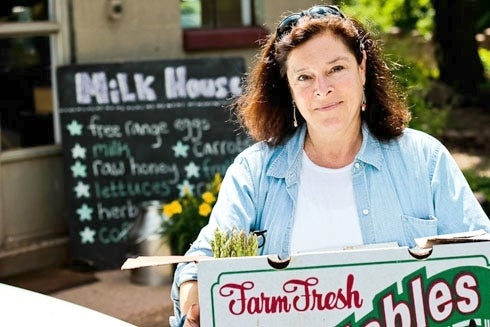
This article was originally published on Bucks County Taste.
Are you ready? Let’s go for a ride.
I’ve known Cathy Snyder for almost six years, since she first decided to step into the food waste stream and do whatever she could to divert some of it to hungry people. Specifically, hungry people in the Delaware River Valley – in Lambertville, New Hope, Doylestown, Quakertown, Bensalem and less known places where our neighbors don’t have quite enough food to get through the week.
I’ve known her as a passionate, funny, loving and serious woman, now a good friend. I’ve even known how she does what she does – bringing fresh vegetables and fruit straight from local organic farms to pantries, churches and people in need.
But I wanted to write a different story.
I asked Cathy if I could ride with her for a day. “This would be a great story,” I thought, “and fun.” We emailed back and forth. “Meet me at 9 am at None Such Farm Market,” Cathy wrote. “Sounds good.” “We should be back by 1 pm. Is that okay?” “Perfect,” I said.
But when you sign up to ride shotgun with Cathy, timing is relative. What’s a number on the clock when there are more fresh greens to be collected and delivered into the shaking hands of a man, just back from chemo treatment, fighting HIV and cancer, but who delights in cooking? 1 pm, 3 pm, 5 pm. It doesn’t really matter, does it?
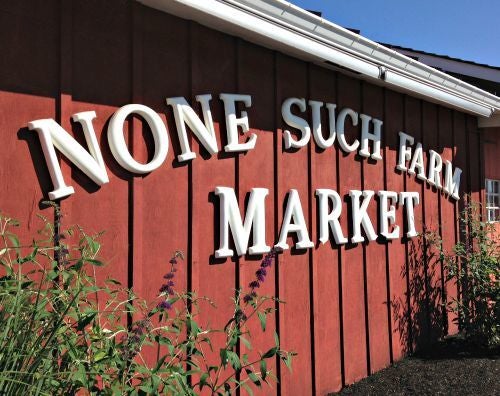
A beautiful start
Our day began at None Such Farm Market in Buckingham, PA on a beautiful, clear 70 degree morning in August – but not quite at 9 am. Some minutes after the hour, the Rolling Harvest Food Rescue Chevy Van pulls into the parking lot. Cathy gets out, and amidst hugs and hellos, apologizes for the lateness and admits she is in desperate need of coffee. “Just let me stop a minute in the market,” she says.
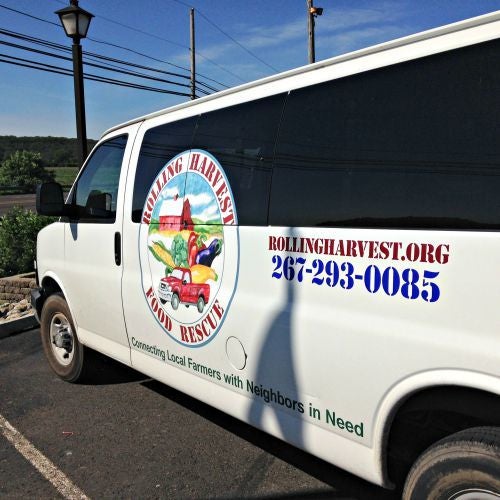
In 2009, Cathy Snyder saw a need. Volunteering at the Fisherman’s Mark food pantry in Lambertville, NJ, she handed out shelf-stable canned goods and perishable goods - some past their “sell by” date. Afterwards, she would cross the river to the New Hope Farmers Market to buy fresh vegetables for her family. The contrast in quality, freshness and nutrition was stark.
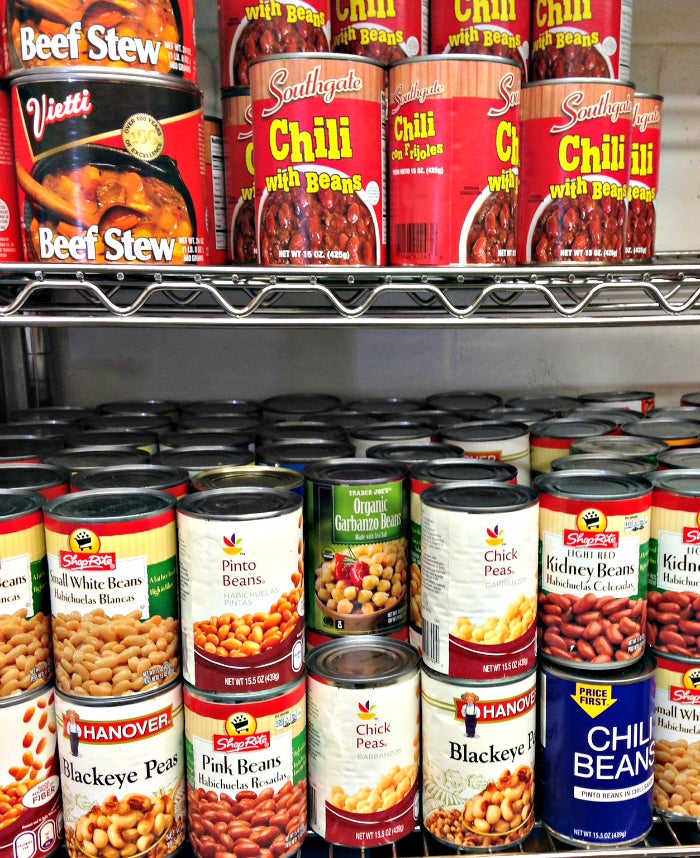
One day she asked the farmers what they did with the product they couldn’t sell that day. “Into the compost heap,” they answered. “Could I take it to a local food pantry instead?” Cathy asked tentatively. The farmers enthusiastically agreed.
That’s Cathy. A passionate, caring person, when she sees a need, she wants to get in with both hands and do something about it. Her resources were few, but enough. Time, gas money and a big Ford Excursion SUV, won in a lottery at the Churchill Downs during one Kentucky Derby a few years ago. “I couldn’t believe we won this huge vehicle. I didn’t know what we were going to do with it,” says Cathy.
In the spring of 2009, the Ford Excursion found itself put to work, as Cathy’s own hunger relief solution, “Gas Guzzling for Good,” got started. As her efforts grew, and she found herself driving to and from 10 donor farms and eight hunger relief sites, with dozens of volunteers helping. Soon she renamed the organization Rolling Harvest Food Rescue.
Rolling Harvest has collected over one million pounds of food since its inception, more than half of that in just the last three years. The fresh, often organic produce reaches 55 hunger-relief sites weekly, with another 28 served bi-weekly, monthly or sporadically. Thirty farm partners contribute, reaching over 20,000 families each month during the harvest season from May to December.
Self-deprecatory and modest, Cathy is still a bit bewildered and amazed by all this. She is uncomfortable in the spotlight, and instead turns it on the farmers (“They work so hard.”) and the people who work at hunger relief sites like churches, pantries, homeless shelters, senior centers and low-income senior housing, group homes, soup kitchens, and domestic violence shelters.
It’s a time sensitive endeavor. And Cathy insists that the produce look fresh and be high quality. She doesn’t want people feeling that they are getting old, second-hand food. “Produce must look good and appealing,” she explains. “We want to turn people onto fresh food.”
Hugs and kohlrabi
Back to stop #1, at the None Such Farm Market. Cathy is desperately searching for hot coffee and some baked goods to bring to volunteers who are helping at a nearby farm. Karen Yerkes, one of the family who owns and farms None Such, comes out from the back and gets a big hug from Cathy, who wants to chat for a minute. This is Cathy too. Despite the constant pressure to keep to the schedule, she always stops for a hug and a smile.
As we head to the cash register, we bump into Rhonda Yerkes. Again, hug, smile and Cathy’s high energy (even without coffee!). A friendly, ongoing disagreement between Rhonda and Cathy resumes. It’s about kohlrabi, that alien-looking vegetable that puzzles buyers and requires a lot of education on the part of the seller. “But it’s a super food!” Cathy exclaims, and I hear the first of what will be several soliloquies that day about the misunderstood kohlrabi, which indeed boasts nine vitamins, seven minerals and lots of potassium, with only 36 calories per serving.
Rhonda, however, shakes her head. “We can’t sell it in the store. No one buys it.” She begs Cathy not to encourage John Yerkes (Karen’s husband) to grow it. With a sheepish smile, Cathy admits her guilt. “I think he may be growing it just for us.”
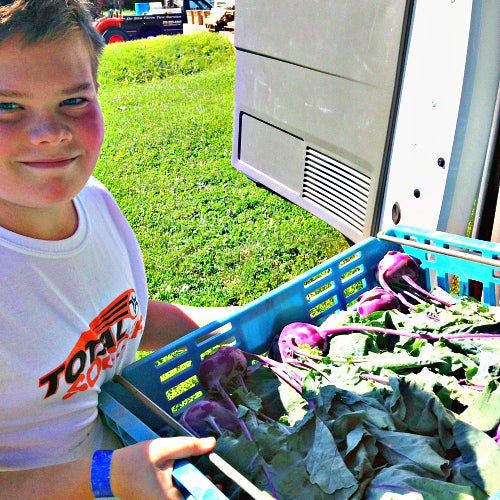
Finally, we’re in the truck, on our way to stop #2, our first produce pick-up, at the None Such Farm just across the road. We pull up to the barn and meet John and his son, Owen. The pick-up is six crates of – you guessed it – kohlrabi, which thrills Cathy to no end and gets her started again on the merits of the much maligned vegetable. (“Did you know it’s a super food?”)
Back in the van, the next stop is the Carversville Farm Foundation, a new organic farm on Mechanicsville Road in Solebury Township, PA. The weather is delicious: sunny, low humidity, blue, blue skies. I’m listening to Cathy, laughing, and trying to write everything down as the truck speeds along. “We have way more fun than we should,” Cathy says.
What is it, and what do I do with it??
In just the few minutes between Buckingham and Carversville, she tells me about an event Rolling Harvest held in early June with the Bucks County Opportunity Council and the Hunger Nutrition Coalition, both partners with the organization.
Over 40 people who help run hunger relief sites all over Bucks attended to hear RHFR’s volunteer nutritionist Vicki Sarnoff teach about vegetables that would be coming soon like kohlrabi and kale, and how to prepare them. Vicki also cooked samples for the attendees and gave recipes for them to take back to their sites. “If they sample, they are much more likely to use,” explains Cathy.
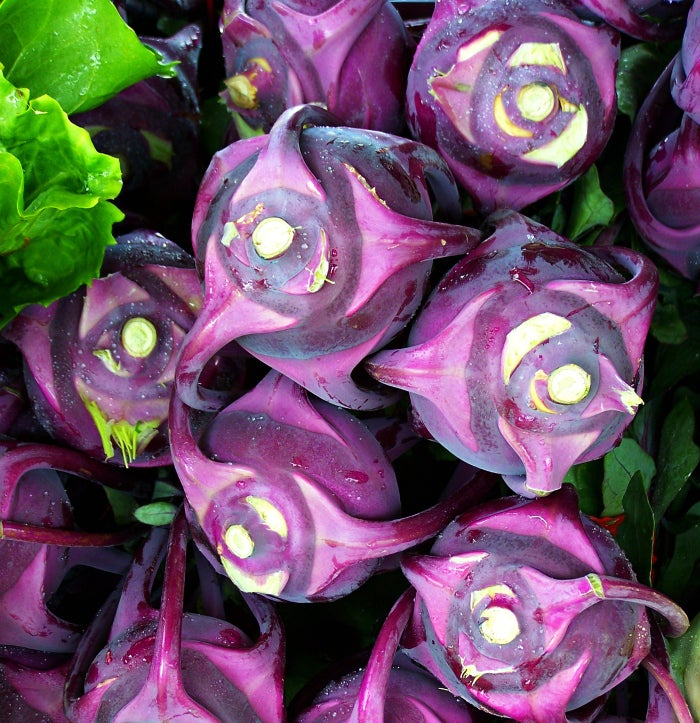
The goal is to give workers at the sites the information and tools they need to educate their population so that the fresh vegetables will be taken and used. RHFR created laminated “Veggie ID” cards which explain about the vegetables in both English and Spanish. They also distributed to each hunger site bi-lingual packets of low-cost, healthy veggie recipes.
“Ninety seven percent said if they didn’t get fresh produce at the pantry, they wouldn’t have it at all.”
Cathy quotes from the survey of food pantry recipients that BCOC and HNC conducted five years ago. “Ninety seven percent said if they didn’t get fresh produce at the pantry, they wouldn’t have it at all. The problem is,” she explains, “the food pantries can’t afford fresh food. But nutrition can be the key to getting some people back on their feet. It’s no longer just about feeding people; it’s about feeding them well.”
We’ve got squash and zucchini
As we’re making the turn onto Route 413, Cathy’s phone beeps and she reads a text message from Alex Sawetsky at Sandbrook Meadows Farm CSA (Community-Supported Agriculture) in Sergeantsville, NJ. “Any interest in squash, zucchini?” Cathy hands me the phone and asks me to text back, “yes” and gives an approximate time we’ll be there. Although she does have a schedule – we have to be at Fisherman’s Mark by 10:30 am – Cathy is always flexible and adjusting her schedule to get every possible vegetable. “I never know what the day will be,” she says, but I don’t think she really minds.
Approximately forty percent of the donated produce comes from daily last-minute calls, emails and texts from farmers who have appealing leftover produce from the previous day’s markets, or have picked an excess that they know they will not be able to sell. Rolling Harvest then dispatches drivers within hours to pick up the product and either delivers directly to hunger sites, or stores it in its large, centrally located, walk-in cooler to be delivered the following day.
In the fields and out of the cooler
At stop #3, the Carversville Farm Foundation, Cathy slows down by the barns and chats with Ron Moule, the farm’s manager. We’re on our way to the fields where Rolling Harvest volunteers are weeding squash plants, now showing beautiful yellow-orange blossoms. The farm is in its first year of cultivation and all of their produce is going into the local hunger relief system.
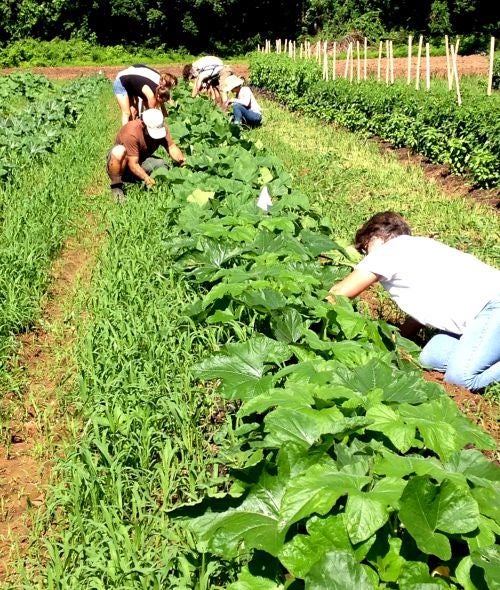
Every Wednesday morning, a dozen or more volunteers show up to weed, pick and do whatever else is needed. Maybe it’s the beautiful weather, but everyone is smiling and obviously enjoying the work. Cathy walks up and down the rows, saying hello to this person, hugging another, and adding to the sunshine in her way. As everyone comes in from the field, the baked goods from None Such are passed around.
Stop #4, just a few minutes away, is Roots to River Farm. In 2013, Malaika Spencer set down her roots at this 60 acre farm in Solebury, PA, leasing over 12 acres from owners Natalie Hamill and Josh Perlsweig, who cultivate a flower farm on the property. Driving on the bumpy dirt road, past Natalie working with the bright-colored flowers, we pull up to the walk-in cooler. Waiting for us are big crates of fresh, beautiful lettuce, beets, turnips, and fennel.

Can’t stop to chat, though, we have to be at the Fisherman’s Mark Food Pantry in Lambertville by 10:30 am. As we speed down Sugan Road, Cathy exclaims, “I have the best office!” On this clear, gorgeous morning, driving from farm to farm and collecting fresh vegetables, I can’t argue.
Stop #5. On Wednesdays from 10:30 am to 2 pm, Fisherman’s Mark sets up a farm stand outside its building, bursting with fresh vegetables and free to those in need. Long-time volunteer Tom Forlenza greets us and helps unload the morning’s “catch.”
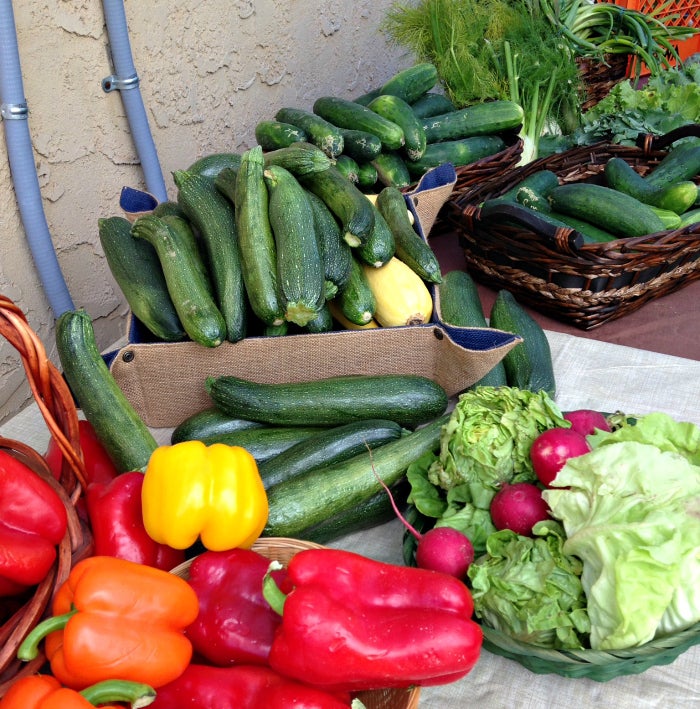
Our next stop (#6) is in Titusville, NJ at Gravity Hill Farm. This organic farm, owned by David Earling and Maria Nicolo, not only sells its own produce but has a beautiful market selling products from a wide variety of local food producers.
We go straight to the cooler in the barn and pull out the crates with Cathy’s name on them. But there’s more. We drive up to the market building to pick up beautiful, bright yellow patty pan squash and fresh zucchini. Cathy shakes her head.
“These are so perfect. I know they’re not giving us the non-sellable (sic) stuff. This looks like it came straight from the fields. I think so many of the farmers are growing more so they can give it to Rolling Harvest, but they won’t admit it. These are not ‘seconds.’”

The critical link
I ask Cathy why there is so much excess produce to be given away. “Farmers always have to plant as much as 30% more than they think they will need to satisfy their customer base because there are so many factors that can affect the harvest—weather conditions, pest damage, labor shortage, lack of demand, low or fluctuating prices.
“For all of these reasons, there is usually a considerable amount of surplus food that is left behind in the fields. If there is no logistic in place to get this food to the hungry, it stays in the field, or gets dumped into compost piles, or for animal feed or, worse, sent to landfills.”
Gleaning organizations like Rolling Harvest are the critical link. They create the logistics for getting the food to where it is needed the most, in a reliable and dependable way that does not tax the limited resources of the farmer or staff at hunger relief sites.
“Farmers know we will be there when it is convenient for them, working around their busy schedules, and that we will take great care to distribute their gift as quickly as possible,” explains Cathy.
“Many of our farm partners do most of the harvesting, and then share what they pick with us after they set aside what they need for farmsteads, markets, CSA shares, etc. And when weather conditions mean a low customer turnout for a particular farm market day, the farmers also call us to collect what is then just two or three days past perfection—also unsaleable by their standards.”
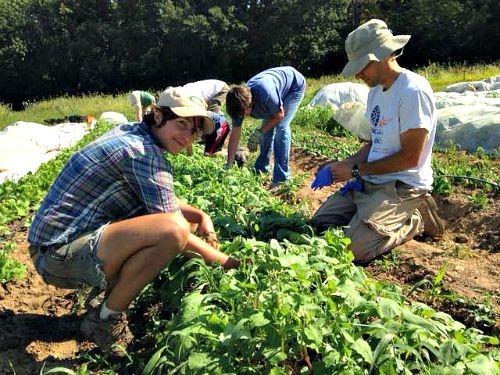
Volunteers are at the core of Rolling Harvest’s operation, Cathy says. More than 80 individuals contribute their time and talents during the harvest season, doing everything from picking up and delivering produce, to nutrition education, setting up free farm markets, working in all types of weather to glean fields, handling IT issues and marketing.
In fact, 20 percent of Rolling Harvest’s produce comes from gleaning the fields of their farm partners. This has become a growing part of RHFR’s weekly activities, and is responsible for ever-increasing yields for donation.
“We have a quick-response harvesting team ready to help within just a day’s notice,” Cathy says. “This ensures that no viable food is left in the fields or is threatened by unexpected weather conditions. We provide the extra labor that the farm is often unable to for the excess food.”
“And when you reap the harvest of your land, you shall not reap all the way to the edges of your field, or gather the gleanings of your harvest; you shall leave them for the poor and the stranger.”
– Leviticus 23.22
As we double back to Fisherman’s Mark to drop off the additional produce (stop #7), Cathy gets a call from Honey Brook Organic Farm CSA in Pennington. Could we stop by? Later this afternoon, Cathy says, giving them an approximate time. She quickly rearranges the schedule in her head. “We can stop there before we go to Blue Moon Acres.”
Lunch and kohlrabi
Stop #8 is the Centenary United Methodist Church in Lambertville which serves up a free, hot lunch every Wednesday for the community. Cathy stops by on Tuesday afternoons with fresh produce so that the kitchen volunteers can plan what they will make the next day.
We walk into the kitchen and plunk down a crate of lettuce on the counter. “Can you use this?” Cathy asks. “Sure!” everyone responds.
This is our chance to get lunch too. In the dining room sit people of all ages from kids to seniors, with a mix of race and ethnicity that reflects Lambertville. If you want a good solid meal or just to have lunch in nice company, stop by some Wednesday.
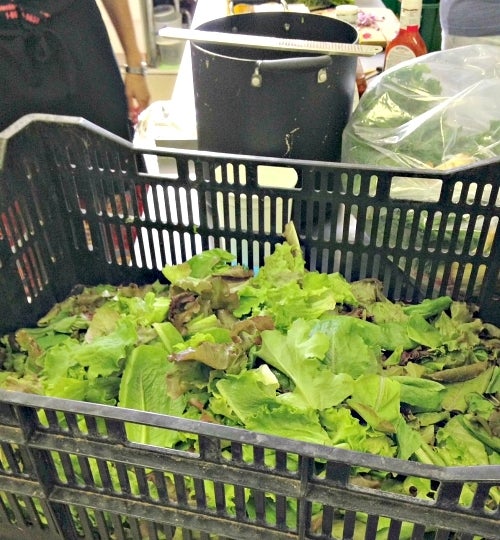
But we’re also dropping off fresh vegetables for people to cook at home. Standing, Cathy addresses the room. “Can I have your attention for a minute?” As everyone quiets, I get the impression this is a weekly occurrence. Cathy introduces this week’s star vegetables, zephyr squash and kohlrabi. Once again she sings the praises of kohlrabi and how to prepare it. By the time we leave, most of the veggies have left for good homes.
Cabbage, onions, mushrooms and more squash
Stop #9 is Sandbrook Meadow Farm, an organic farm and CSA, located between Stockton and Sergeantsville, NJ. Waiting for us are crates and crates of first quality zucchini and yellow squash. Back in the truck, Cathy estimates we got about 210 pounds and marks it in her log.
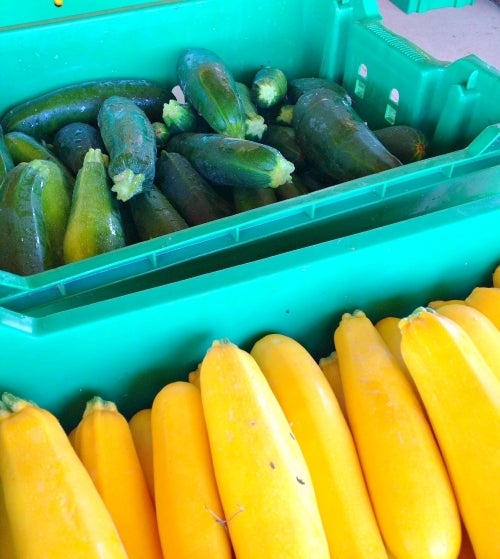
Honey Brook Organic Farm in Pennington, NJ, one of the oldest and biggest organic CSA farms on the East Coast, is our next stop (#10) where we pick up cabbage, greens and onions. From there we go to Blue Moon Acres, also in Pennington.
I’m in a daze. Bumping along New Jersey back roads, beautiful blue skies with puffy clouds, listening to Cathy’s passionate voice.
As we pull around to the back of the Blue Moon market (stop #11), we see owner/farmer Jim Lyons weeding nearby in his rice fields. You heard me right. Rice fields. In New Jersey. Jim has been cultivating rice for the past three years and now offers certified organic, freshly husked rice in several varieties. Blue Moon Acres is best known for their microgreens (at their farm in Buckingham) but they now grow all kinds of produce at their organic farm in Pennington.
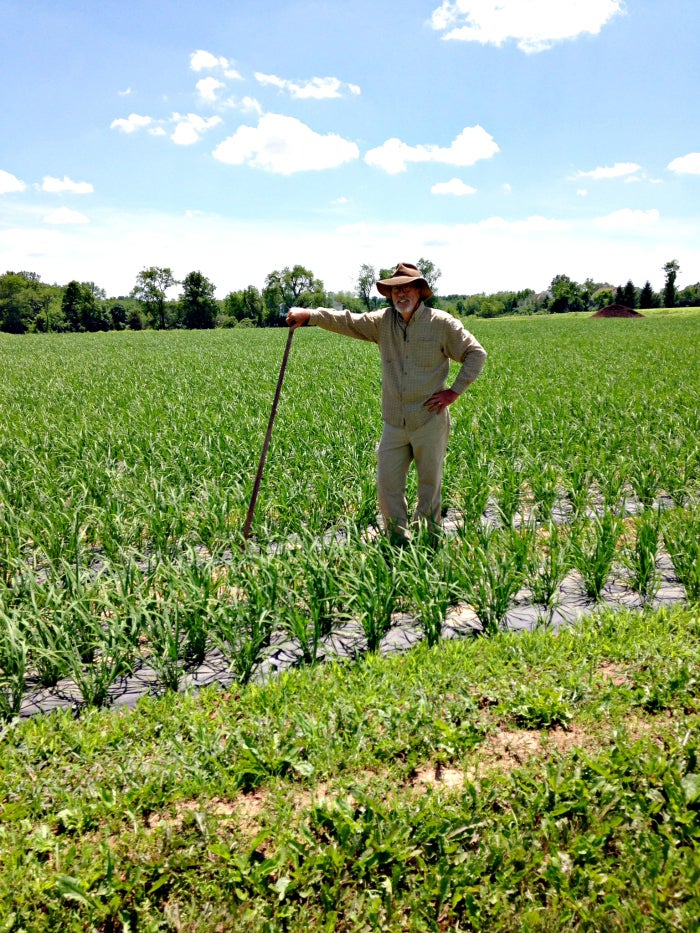
Fresh, organic veggies vs. overripe bananas
Cathy is anxious to get back to Lambertville. We have to get vegetables to the Lambertville Food Pantry in time for their 2 pm opening (stop #12). In fact, people start lining up at 1:45. The pantry is only open on Wednesdays from 2 – 4 pm, and Saturdays from 10 am – 12 pm.
Imagine. What if you had to be at a certain place at a certain time and day – early even – to get food, or you would miss out?
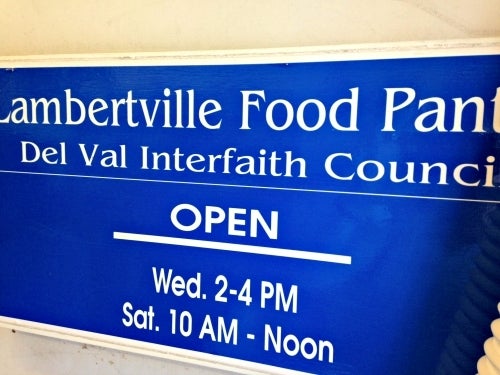
We pull up to the pantry, located on the side of St. John the Evangelist Catholic Church, and place the crates of fresh, organic veggies outside the tiny food pantry where people are lining up to get what they can – meat, bread, canned goods – before the shelves are emptied. Inside it’s stuffy and crowded with two “aisles” where people are trying to decide – quickly – whether they want the canned chili or box of mac n’ cheese. Or the bruised, overripe bananas.
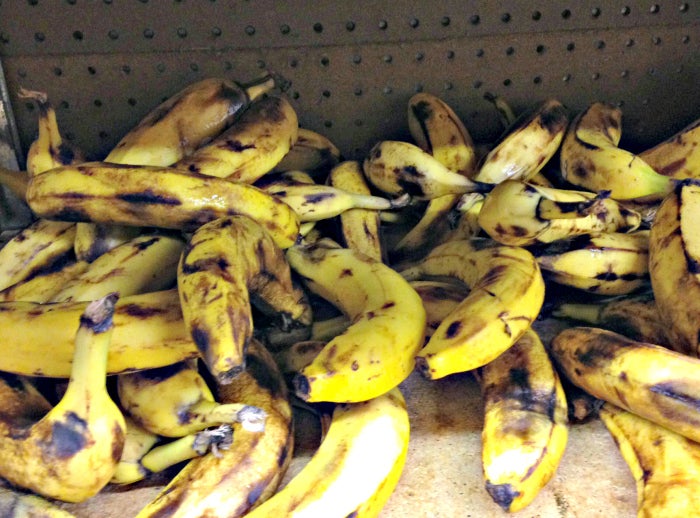
The day is not over, however. Cathy apologizes for not meeting her promised 1 pm deadline of getting me back to None Such. I keep telling her it’s okay. I have come to realize that I have nothing more important to do that afternoon.
By now my notes are deteriorating into scribbles and I’ve lost count. Is this stop #13 or #14? (#13, I later figure out.)
Rescue in the cooler
Just south of Lambertville, Rolling Harvest has a large walk-in cooler where its volunteers can drop donated produce if it can’t be delivered to a hunger relief site that day. Cathy says she has to stop and see what is there, and get it to the food pantry before it closes at 4 pm.
Stepping into the cooler is a relief from the hot afternoon outside. We start picking through boxes of donated lettuce, cilantro, greens. What’s still good? It has to be fresh and good-looking, says Cathy, so we tear off the damaged outside leaves and Cathy cuts off the browned stems. And, it does look good! It’s amazing what we consider “bad” in our produce and the resulting food waste.
“Produce must look good and appealing,” Cathy explains. “We want to turn people onto fresh food.”
We rush back to the food pantry and drop off lettuce and cilantro and then make our way to stop #14, the Little Haven Rest Home, a senior living facility in Lambertville. Two wonderful ladies cook for 35 men on a food budget of $1,200/month. We show them what we have in the truck and they calculate in their heads what they can store, use and cook.
Stop #15 is a small house on a quiet back street in New Hope, PA. Run by Bucks County, it’s home to 10 men with HIV who have no place else to live. Cathy is really hoping to see Bob, one of the residents who has become a good friend. We wait a few minutes (Cathy and Bob have been texting) and finally he arrives, returning from chemotherapy treatment in Philadelphia. Hugs and kisses ensue, of course.
Bob is very weak from his treatment, using a walker to get around, but is thrilled to see the bounty we have brought him. It turns out he is a superb cook; indeed it is “his greatest love,” Cathy tells me. She has been saving the mushrooms we picked up at Blue Moon Acres just for him (“The medicinal value of mushrooms is incredible; it will help him with the cancer”).
As we stand in the kitchen, looking over a table filled with vegetables that makes me tired just looking at them, Bob, even in his weakened state, is so excited, describing what he will do with it all.
Barbecue chicken and pasta
Finally we are on our way back to None Such Farm Market and my car. But on the way a text comes in to Cathy’s phone. It’s from Matt Felegyhazi, owner/chef of Modern Palate catering.
“I’m finishing up a corporate catering job and will have 100+ BBQ chicken pieces and pasta left over. Can you use it?” I relay the message to Cathy but I’m flummoxed. How can she do anything with that so late in the day?
But she calls Matt back and they problem-solve. “Where’s your kitchen?” Cathy asks. “Colmar,” he replies. “Can you freeze it today when you get back? We have a distribution in New Britain tomorrow. We can get it out to people.” They make the final arrangements for the pick-up the next day.
It’s 4:30 pm when we reach None Such. I’m exhausted and dazed. She does this every day? Yes, and no, Cathy explains.
“Today is the heart of how it got started – picking up from small farms, delivering to pantries, churches, homes, etc.
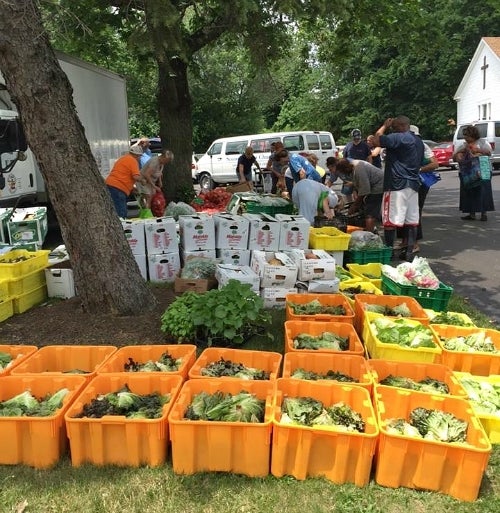
“But then we partnered with the Bucks County Opportunity Council and their hunger relief network. Now we also do mass distributions twice a week, in Bensalem and New Britain, giving out thousands of pounds of rescued food to more than 45 hunger relief sites who take back the food immediately to their neighborhoods.”
“We can all relate to hunger,” Cathy says. “But many people don’t know they can do something about hunger and food waste right here.”
Stepping into the food waste stream
When Cathy and I were standing outside the crowded Lambertville Food Pantry, an image suddenly transposed itself on the scene. The bi-annual food truck fair that takes place in Lambertville, just one street away. Thousands of people – let’s be honest – stuffing their faces with all kinds of delicious food. It was too stark a contrast. We are living side by side with hungry people and we either don’t see it or don’t realize it. But it’s not about guilt. It’s about gratitude for what we do have and asking, “What can I do?”
“We can all relate to hunger” Cathy says. “But many people don’t know they can do something about hunger and food waste right here.”
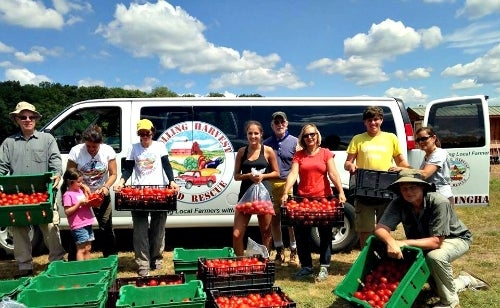
If you are interested in volunteering your skills, time and/or donating money to Rolling Harvest — especially during the growing season – learn more at their website, www.RollingHarvest.org.
